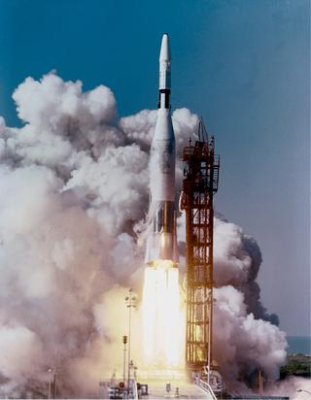Making mendelevium, one atom at a time?

The discovery of mendelevium was announced at the end of April in 1955. It was described by one of its discoverers as "one of the most dramatic in the sequence of syntheses of transuranium elements".
The search for new elements is something that scientists have been doing for hundreds of years. Once Russian chemist Dmitri Mendeleev organised the elements known at his time according to a repeating, or periodic (and hence the name periodic table), system in the 1860s, the search became a little easier.
This was because the gaps in Mendeleev's periodic table pointed to elements that weren't known yet. The properties of these elements, however, could be predicted based on their place in the table and the neighbours around them, thereby making it easier to discover new elements. Mendeleev's table has since been expanded, to make space for other new elements
One of those new elements discovered was element number 101, named mendelevium after. Mendeleev. American Nobel Prize winner Glenn Seaborg, who was one of the discoverers of the element, wrote that the discovery of mendelevium was "one of the most dramatic in the sequence of syntheses of transuranium elements", in a chapter co-written by him for The New Chemistry. Additionally, he also wrote in that chapter that "It was the first case in which a new element was produced and identified one atom at a time."
Begins with a bang
Ivy Mike, the first thermonuclear device, was dropped for testing on the Eniwetok Atoll in the Pacific Ocean in 1952, sending a radioactive cloud into the air, from which samples were collected. The lab reports suggested that two new elements-elements 99 (einsteinium) and 100 (fermium) - were discovered from the debris. The discoveries came at a time when there was a race to discover new elements.
The leading researchers of the U.S. involved in this race were camped at the Radiation Laboratory at the University of California, Berkeley, under the direction of physicist Ernest Lawrence A team of scientists which included Albert Ghiorso, Stanley Thompson, Bernard Harvey, Gregory Choppin, and Seaborg, came up with a plan to produce element 101 using a billion atoms of einsteinium-253 that were formed in a reactor.
The idea was to spread the atoms of einsteinium onto a thin gold foil. As its half-life was about three weeks, the researchers effectively had a week to perform their experiments after receiving it. Based on Ghiorso's calculations, they were aware that only about one atom of the new element 101 would be produced for every three hours the gold foil was bombarded with alpha particles.
Race against time
As the experiment would yield only a very small amount of the new element, the scientists set up a second gold foil behind the first to catch the atoms. It was a race against time as well as the half-life of element 101 was expected to be a few hours only.
With the Radiation Laboratory atop a hill and the cyclotron at its base, there really was a mad rush to get the samples to the lab on time. The samples "were collected in a test tube, which I took and then jumped in a car driven by Ghiorso", is how Choppin put it in his own words.
On the night of the discovery, the target was irradiated in three-hour intervals for a total of nine hours. By 4 AM on February 19, 1955, they had recorded five decay events characteristic of element 101 and eight from element 100, fermium. With conclusive evidence of element 101's existence, Choppin mentions that "We left Seaborg a note on the successful identification of Z =101 and went home to sleep on our success."
At the end of April 1955, the discovery of element 101 was announced to the world. The university's press release stated that "The atoms of the new element may have been the rarest units of matter that have existed on earth for nearly 5 billion years... The 17 atoms of the new element all decayed, of course, and the 'new' element is for the present extinct once again."
Cold War era
As element 101 marked the beginning of the second hundred elements of the periodic table, the scientists wanted to name it after Mendeleev, the man behind the periodic table.
Despite the discovery happening during the Cold War era, Seaborg was able to pull enough strings to convince the U.S. government to accept the proposal to name the element after a Russian scientist. The International Union of Pure & Applied Chemistry approved the name mendelevium and the scientists published their discovery in the June 1955 issue of Physical Review Letters.
While only small quantities of mendelevium have ever been produced, more stable isotopes of the element have since been made. The most stable version known as of now has a half-life of over one-and-a-half months, allowing for better opportunities to further study heavy elements and their properties.
Picture Credit : Google